06 April 2021
New Lime Factsheet – The Facts on Applying Lime

Lime is most definitely the forgotten fertiliser on Irish farms. We are currently only applying 50% of our national lime requirements. In addition 80 to 85% of our soils are testing sub-optimal for major nutrients such as soil pH, P & K. Mark Plunkett, Teagasc Johnstown Castle has more information.
Lime will be a key technology in the toolbox to increase sustainability on farms and will help to meet new environmental targets set out in the EU Green Deal and the Farm to Fork and Biodiversity strategies. Efficient N use starts with correcting soil pH. For example we can double our N efficiency by correcting soil fertility (pH, P & K) thus reducing fertiliser N use and reducing costs.
Changes in timing of lime applications is required
Traditionally, the back end of the year i.e. October, November and December, was the main period for applying lime. On average, over the last 5 years, these months have been the wettest, as 30% of our annual rainfall comes at this time of the year. Waiting until the late season to apply lime will generally result poorer and less trafficable soil conditions and the opportunity to apply lime could be missed. Therefore, aim to apply lime earlier in the year when soil and weather condition are move favourable. We can capitalise the benefits of liming to use N more efficiently and to help reduce the total farm N requirements, while at the same time protecting the environment.
Get the Facts on Lime & Take Every Opportunity
When it comes to applying lime we must take every opportunity during the growing season. Lime can be spread any day of the year provided soil and weather conditions are suitable. The new factsheet on lime answers a number of the common questions / myths when it comes to applying ground limestone to Irish soils. Download the PDF here
1 – PADDOCK AVAILABILITY
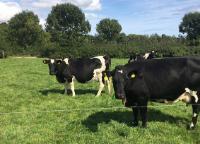 Once fields have been grazed-off and grass covers are low, it is an ideal time to apply lime. Identify blocks of land that require lime, for example this could require ordering a load of lime (20t) after each grazing rotation to correct soil pH (covers approx. 10 ac @ 2t/ac lime application rate). Aim to avoid high grass covers > 800kg DM/ha.
Once fields have been grazed-off and grass covers are low, it is an ideal time to apply lime. Identify blocks of land that require lime, for example this could require ordering a load of lime (20t) after each grazing rotation to correct soil pH (covers approx. 10 ac @ 2t/ac lime application rate). Aim to avoid high grass covers > 800kg DM/ha.
2 – LIME RESIDUE ON GRASS
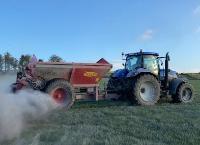 Ideally apply lime to low grass covers to reduce the risk of lime residues. Rainfall will typically wash most of the lime from the grass down to the soil. Where a small amount of lime remains on the leaf will not affect grazing animals. Grass covers on farms tend to be lowest (500kg DM/ha) during April and August (PastureBase Ireland (PBI)) and presents good timing for lime application.
Ideally apply lime to low grass covers to reduce the risk of lime residues. Rainfall will typically wash most of the lime from the grass down to the soil. Where a small amount of lime remains on the leaf will not affect grazing animals. Grass covers on farms tend to be lowest (500kg DM/ha) during April and August (PastureBase Ireland (PBI)) and presents good timing for lime application.
3 – SOFTENING OF THE GROUND / SOD
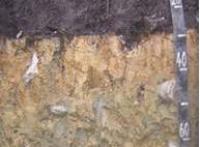 Soil types where a relatively thick (5-10cm) organic layer has formed above the top soil may be more prone to poaching during wetter period of the year. This organic layer holds a large store of acidity. Liming these soils to neutralise acidity and raise pH will create favourable conditions for biological activity (e.g. grass roots, earth worms, etc…) and the release of the nutrients stored in the organic matter.
Soil types where a relatively thick (5-10cm) organic layer has formed above the top soil may be more prone to poaching during wetter period of the year. This organic layer holds a large store of acidity. Liming these soils to neutralise acidity and raise pH will create favourable conditions for biological activity (e.g. grass roots, earth worms, etc…) and the release of the nutrients stored in the organic matter.
As nutrients are released from organic matter, the resistance of the top few centimetres of soil to heavy trafficking may be temporarily reduced. To minimise these effects apply lime on “a little and often basis” and improve soil pH in stages over time. Don’t exceed 5t/ha in a single application or apply split applications (2.5t/ ha) over a number of years.
4 – SILAGE FIELDS
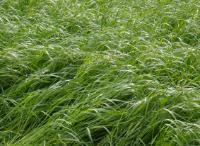 Leave sufficient time (up to 3 months in dry weather) between applying lime and closing for grass silage for the lime to be fully washed into the soil. If lime is transported to the silage clamp or picked up in the baled silage, it may affect good preservation conditions for the silage (acidic conditions).
Leave sufficient time (up to 3 months in dry weather) between applying lime and closing for grass silage for the lime to be fully washed into the soil. If lime is transported to the silage clamp or picked up in the baled silage, it may affect good preservation conditions for the silage (acidic conditions).
5 – LIME & SLURRY
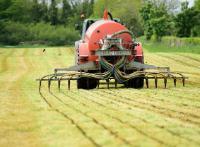 Spreading cattle slurry on fields that have received lime recently or freshly limed land, where the lime has not had sufficient time or rainfall to be washed into the soil, can result in a loss of up to 50% of the available slurry N. To minimise these N losses from slurry apply cattle slurry first and then apply the lime 7 to 10 days later.
Spreading cattle slurry on fields that have received lime recently or freshly limed land, where the lime has not had sufficient time or rainfall to be washed into the soil, can result in a loss of up to 50% of the available slurry N. To minimise these N losses from slurry apply cattle slurry first and then apply the lime 7 to 10 days later.
6 – LIME & UREA
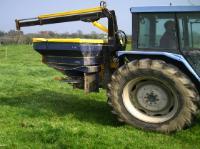 For urea, a similar situation to cattle slurry where increased N loss (ammonia-N volatilisation) may occur where straight urea fertiliser is applied on recently limed land. Therefore apply urea first and apply the lime 7 to 10 days later to reduce the risk of N losses. However, where protected urea is being applied, early trial work indicates that it is safe to apply protected urea to fields that have been limed recently.
For urea, a similar situation to cattle slurry where increased N loss (ammonia-N volatilisation) may occur where straight urea fertiliser is applied on recently limed land. Therefore apply urea first and apply the lime 7 to 10 days later to reduce the risk of N losses. However, where protected urea is being applied, early trial work indicates that it is safe to apply protected urea to fields that have been limed recently.
7 – LIME & HIGH MOLYBDENUM SOILS
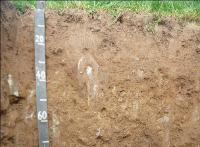 Soils with high Mo status may increase the risk of inducing a copper deficiency in grazing animals. On these soils increasing soil pH above pH 6.2 increases the availability of Mo in the soil and higher uptake of Mo by actively growing grass. Where farms are affected by high Mo soils maintain soils at or below soil pH 6.1 – 6.2. Alternatively, apply lime as recommended and supplement animals with copper.
Soils with high Mo status may increase the risk of inducing a copper deficiency in grazing animals. On these soils increasing soil pH above pH 6.2 increases the availability of Mo in the soil and higher uptake of Mo by actively growing grass. Where farms are affected by high Mo soils maintain soils at or below soil pH 6.1 – 6.2. Alternatively, apply lime as recommended and supplement animals with copper.
8 – SPEED OF REACTIVITY
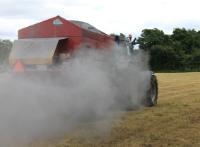 Once lime is applied and is washed in it starts to adjust soil pH. At least 35% of ground limestone (350 kg/tonne) has a particle size < 0.15mm. This component of the lime is fast acting and very reactive and will start working immediately (0-6 months). The remaining 65% lime (650 kg/tonne) will be broken down in the soil in the medium term (6-24 months) and helps to maintain soil pH levels in the longer term until the soils are re-sampled in year 4-5.
Once lime is applied and is washed in it starts to adjust soil pH. At least 35% of ground limestone (350 kg/tonne) has a particle size < 0.15mm. This component of the lime is fast acting and very reactive and will start working immediately (0-6 months). The remaining 65% lime (650 kg/tonne) will be broken down in the soil in the medium term (6-24 months) and helps to maintain soil pH levels in the longer term until the soils are re-sampled in year 4-5.
9 – RETURN ON INVESTMENT (ROI)
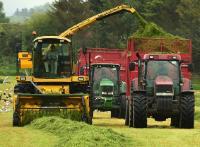 Research shows that liming acidic soils increases grass production by 1.0t DM/ha. On a drystock farm this is valued at €105/tonne DM and €180/t DM on a dairy farm. An application of 5t/ha of ground limestone to correct soil pH represents a cost of €25/ha/year over 5 years. The return on investment from lime gives €4 to €7 worth extra grass for every €1 invested in lime.
Research shows that liming acidic soils increases grass production by 1.0t DM/ha. On a drystock farm this is valued at €105/tonne DM and €180/t DM on a dairy farm. An application of 5t/ha of ground limestone to correct soil pH represents a cost of €25/ha/year over 5 years. The return on investment from lime gives €4 to €7 worth extra grass for every €1 invested in lime.
10 – LIME TYPE
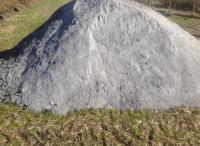 There are two main types of ground limestone that are available nationally – Calcium & Magnesium. Calcium lime is most widely available while Magnesium is mainly available in the South East.
There are two main types of ground limestone that are available nationally – Calcium & Magnesium. Calcium lime is most widely available while Magnesium is mainly available in the South East.
For more information visit: www.teagasc.ie/crops/soil–soil-fertility/
